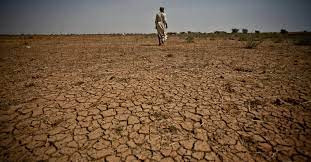
THIS year’s summer is very unusual; at times it’s hot, but it may also be windy. In the early hours of the day, it is very cold, but as the day progresses, the temperatures drastically rise.
These must be the effects of climate change.
While for some people summer is always celebrated by holidaying, as everyone has ways to beat the summer heat, the same cannot be said for farmers in animal husbandry.
During summer, cattle, pigs, goats, sheep, chickens and any other animal farms go through heat stress.
Worse, there isn't enough grazing as most of it is usually consumed by veld fires.
By this millennium, farmers in Zimbabwe should not have to worry about how to keep their herd healthy in summer.
Here are some researched notes on how to beat summer in animal husbandry.
Winter planting
- COP26 a washout? Don’t lose hope – here’s why
- Out & about: Bright sheds light on Vic Falls Carnival
- COP26 a washout? Don’t lose hope – here’s why
- Out & about: Bright sheds light on Vic Falls Carnival
Keep Reading
Farmers need to start planting winter crops like wheat, millet and barley so that during the summer season they can easily feed their animals. The planting does not necessarily have to be commercial. You can actually plant just for the cattle. There are also certain grasses like lucerne, katambora and many others that grow in winter that farmers should look out for.
If your farm is experiencing heat stress or drought, it is always important to make sure that grazing pastures get more rest than usual so that your plants come back with a bang after the onset of rain. Supplement with silage or feed if necessary.
Use summer annuals to ensure a steady supply of forage.
Summer planting
Use summer annual forages like millet, sorghum or sudangrass to provide a rich feast of delicious forage for grazing in summer, when perennial grasses are usually low in quality and quantity. The options for summer annuals are plenty and you need to decide what the right mix for your pasture is.
With sod-forming perennial grasses like Bermudagrass, grazing should begin only when the average height of the plant is 10 mm. Grazing should stop when the plant is less than 4 mm in height.
With native warm-season grasses like Eastern gamagrass, rotational grazing can be followed after the cattle have been removed and when the height of the plant touches 8–10 mm. Graze each paddock for less than seven days and allow a rest period of 28–45 days between rotations, as per the weather.
If you graze continuously, it will cause a loss of stand.
Remove your cattle from native warm-season pastures by the end of August. This allows the roots to store a good amount of carbohydrates, enough to survive the winter.
One thing to note is that warm-season forages usually have a low nutritive value when compared with cool-season forages. So, you may have to consult a livestock nutritionist to make sure that your herd is getting what they need.
You could always supplement their diet if the nutritionist advises you to do so.
Using summer crops is also a good way to prevent overgrazing but, wait for a second, let's back up here a bit and talk about pasture management in summer on the whole, before zeroing in on overgrazing and summer crops.
Pasture management in summer
What is the main difference between summer and other seasons?
In summer, the leaf emergence rate and overall growth of the pasture are much slower due to dryness and lack of moisture.
As we discussed earlier, increasing the number of days in your rotation is a great way to up your growth and increase the quantity of feed for the autumn season that will pop by quickly enough.
Allocating pasture allowance
In non-irrigated areas that are super dry due to the hot summer months, high temperatures and moisture stress cause an accumulation of dead material in the base of the pasture.
This will end up increasing the dry matter percentage and fibre but also reduces the quality of pasture. This is something that needs to be considered when you're allotting daily pasture allowances.
Summer nutrition
As the dry matter percentage increases in summer pasture, there is much more dry matter for cows to eat in summer, compared to spring.
A good rule to remember is that a cow in mid-lactation requires approximately 16% crude protein.
If you are low on protein during the summer, opt for a supplement that's high in non-degradable dietary protein, also called UDP, which is required to generate a milk solids response. Feeding supplements that have high values of rumen degradable protein or RDP, will not help improve production.
It's also important to be mindful of some summer strategies that will keep your herd healthy and happy.
Heat stress: Make sure that you identify heat stress in your cattle right from the early stages and take the necessary measures.
Feeding supplements keeps animals in production longer than would be possible during a dry summer.
If it suits you and your cows, milking once a day or three times in two days can take the pressure off your cows.
Reduce demand by culling low producers.
Irrigation
Something we usually advise farmers who face these types of challenges is to fully water the best part of your farm, rather than wasting resources in fully watering the entire farm.
Do not over-graze
Most of a plant's reservoir of energy is usually stored in the bottom 4cm of the plant. Over-grazing pastures reduces these energy stores and thus, the plant ends up re-growing very slowly once the moisture comes in, during the autumn rains. Overgrazing, again and again, can even cause plant deaths in summer.
You have to make sure the pasture is managed so well that as soon as it rains, the pasture springs up and responds beautifully.
Instead of overgrazing, you can turn to other options like:
Incorporating summer crops (like we mentioned above)
Culling low-producers so that your demand is reduced
Supplemental feed
Using stand-off facilities
Your post-grazing residuals should not be bigger than 4,5 cm in summer. If there are higher residuals than this, it causes pasture quality to deteriorate.
Dead material in the base of the pasture will rot in rainfall.
In areas that are susceptible to facial eczema these high residuals coupled with the dead matter in the base of the sward increase the chances of facial eczema and high spore counts.
Instead of under-grazing, you could:
Check your residuals after grazing is done and then adjust your allocation allowance accordingly
Measure your pre-grazing covers
Eliminate supplements
Follow these tips, farmer friends, and we are sure that you will be looking forward to making the most out of summers spent with your cows!
Gwabanayi is a practising journalist and a farmer in his own right. — 0772 865 703 or [email protected]










